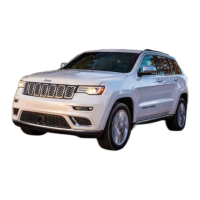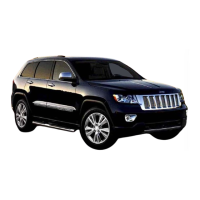Do you have a question about the Jeep Grand Cherokee 2017 and is the answer not in the manual?
Guide on manual navigation, information access, and symbol interpretation.
Highlights the higher rollover risk of utility vehicles due to their design and provides safety advice.
Explains the importance of observing warnings and cautions for safe operation and vehicle protection.
Details the operation and features of the key fob for locking, unlocking, and starting the vehicle.
Explains the Keyless Enter-N-Go ignition system, its modes (OFF, ACC, RUN, START), and backup methods.
Details manual and power seat adjustments, including heating, ventilation, memory, and fold-flat features.
Explains the function and proper adjustment of head restraints to minimize neck injury in a crash.
Covers adjustment and features of inside day/night and automatic dimming mirrors, and outside mirrors.
Explains operation of headlight switch, automatic headlights, fog lights, and parking/panel lights.
Overview of climate control system, including AUTO mode, defrost, recirculation, and temperature adjustments.
Details power window controls, auto-down/up features with anti-pinch, and window lockout switch.
Covers operation of the power sunroof, including express open/close, venting, and pinch protection.
Explains the base instrument cluster layout and its various gauges and indicators.
Details the driver interactive display, menus, and controls for accessing vehicle information.
Describes the various warning and indicator lights found on the instrument panel.
Covers seat belt systems, SRS airbags, active head restraints, and child restraints.
Provides legal requirements and recommendations for restraining children, including LATCH system usage.
Information on tire markings, terminology, pressure, loading, and general safety.
Pre-start checks, normal starting procedure using the START/STOP button, and engine failures.
Details gear selector positions, shift interlocks, ECO mode, and eight-speed automatic transmission.
Explains Quadra-Trac I and II systems, including HI, NEUTRAL, and LOW range operations.
Details Selec-Terrain modes (Snow, Auto, Sand, Mud, Rock) and their usage for different terrains.
Instructions on activating, setting, varying, and deactivating Speed Control (cruise control).
Explains ACC operation, modes, activation, cancellation, and settings for following distance.
Describes visual and audible indications of distance to obstacles and automatic braking during parking.
Explains Lane Departure Warning and strength settings, and how the system provides visual and haptic feedback.
Describes the on-screen image of rear surroundings, caution notes, and programmable modes.
Instructions on opening the fuel filler door, emergency refueling, and fuel type recommendations.
Safety tips, load limits, hitch classifications, and towing recommendations for trailers.
Advice for on-road and off-road driving, including handling utility vehicles and driving through water.
Explains the operation and usage of hazard warning flashers for emergency situations.
Details the function of SOS and ASSIST buttons for emergency and roadside assistance.
Provides a list of interior and exterior bulb numbers for replacement.
General information on fuses, their purpose, and warnings regarding replacement.
Instructions on jack location, spare tire stowage, preparations, and tire changing procedures.
Procedures and precautions for jump starting a vehicle with a discharged battery.
Steps to take to reduce overheating potential and what to do if the engine overheats.
Procedure for manually releasing the parking brake when the transmission cannot be shifted out of PARK.
Techniques for moving a vehicle stuck in mud, sand, or snow using a rocking motion.
Procedures for towing a disabled vehicle using commercial services or recreational towing.
Details the automatic oil change indicator system and recommended service intervals based on mileage or time.
Identifies key components within the engine bay for the 3.6L and 5.7L engines.
Covers tire safety, general information, types, tread wear indicators, and inflation pressures.
Explains the benefits and procedure for rotating tires to ensure even wear and optimal performance.
Provides information on the Vehicle Identification Number (VIN) and its locations.
Details the dual hydraulic brake system, its capabilities, and potential warnings for system loss.
Specifies proper lug nut/bolt torque values and patterns for mounting wheels securely.
Outlines recommended fuel types, octane ratings, and cautions for 3.6L and 5.7L engines.
Lists U.S. and Metric capacities for fuel, engine oil, and cooling system.
Recommends specific fluids and lubricants for engine, transfer case, and axles.
Guides on accessing and changing customer programmable features via touchscreen and faceplate buttons.
Settings for display mode, brightness, and themes, including how to make changes.
Explains voice response length and show command list settings for voice recognition system.
Covers settings for ParkView Backup Camera, Forward Collision Warning, and LaneSense.
Details ParkSense system settings for audible alerts and braking assist for parking.
Settings for blind spot monitoring system alerts (Off, Lights, Lights and Chime).
Advice on preparing for appointments, making lists of problems, and being reasonable with requests.
Refers to the Warranty Information Booklet for terms and provisions of FCA US LLC warranties.
Instructions on how to report vehicle safety defects to NHTSA and FCA US LLC.
| Brand | Jeep |
|---|---|
| Model | Grand Cherokee 2017 |
| Category | Automobile |
| Language | English |











